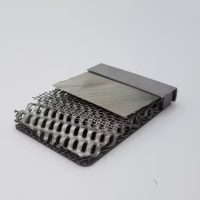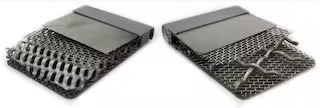Home » News » Article Releases » Article: Pressure filter leaves for food and beverage applications
Article: Pressure filter leaves for food and beverage applications
Food and beverage processors use pressure leaf filtration to remove fine sediments that spoil the flavor, texture and appearance of beverages, as well as leftover yeast and bacteria that can compromise shelf life of fermented beverages.
Kevin Gilbert
April 21, 2022

Pressure leaf filters have been a key component of liquid processing since the 1940s. Many industries that require micron scale solid particles filtered out of large volumes of liquid rely on pressure leaf filtration as the most efficient, durable and dependable filtration method.
Filter leaves are the functional components of the pressure leaf filter vessel. Depending on the vessel type, leaves may be either horizontally or vertically stacked in the vessel. Round, square or rectangular, filter leaves are all based on a heavy spacer mesh at the core, sandwiched between layers of successively finer mesh. The space between the completed leaf assemblies is then packed with a filtration media, usually diatomaceous earth (DE), which captures the sediment particles in the liquid being filtered.
Food and beverage processors use pressure leaf filtration to remove fine sediments that spoil the flavor, texture and appearance of beverages, as well as removing leftover yeast and bacteria that can compromise shelf life of fermented beverages. Different grades of DE media are optimal for different applications, and different grades of DE media require different mesh sizes. For example, the perfect filter setup for clear spirits may turn a complex red wine into a bland rose. In addition to beverages, pressure leaf filters are widely used to filter food ingredients and additives such as sweeteners, syrups, food oils, gelatin and pectin.
Beyond the food and beverage sector, pressure leaf filtration is used in chemical processing, mineral extraction, precious metal refining, brine processing and more. Each of these applications presents unique filtration, corrosion and cleaning challenges. An experienced mesh expert has seen it all and can select the right mesh for the right application.
Pressure leaf filter manufacturers and aftermarket refurbishers can expect more from their mesh supplier than just providing bulk material. A quality mesh partner will have the experience and equipment to take on much of the preparation and assembly work of filter leaf fabrication and refurbishing, freeing the filter manufacturer to focus on system design and fabrication while reducing their demand for labor and equipment. The more innovative wire mesh companies are actively looking for ways to help their customers improve product performance and reduce cost. Some mesh companies can be more competitive than others without sacrificing quality or dependability. They accomplish this by maintaining a diverse supply chain that includes their own wire mills and looms combined with their large volume purchasing power for globally sourced materials.

Anatomy of a filter leaf
Regardless of manufacturer, all pressure leaf filters consist of a pressure vessel full of DE media, and some configuration of mesh to contain the DE media and prevent it from flowing out of the vessel with the clean filtrate. Decades of use across numerous industries have demonstrated the following common filter leaf features:
- The core layer is typically a very heavy gauge woven mesh or expanded mesh. It must be quite rigid to help the finished leaf stand up to the system’s operating pressure.
- Sandwiching either side of the center layer of mesh is an intermedia mesh layer whose sole job is to support the outer layer and prevent it from deforming into the center layer under pressure.
- On either side of the intermediate layer is a final layer of fine wire mesh filter cloth. This outer layer mesh is selected based on the grade of DE media most suitable for the application.
- To complete the assembly, the outer wire mesh layers are welded to a perimeter frame, or the mesh layers are riveted through a formed channel frame which sandwiches the edges of the mesh layers. The perimeter frame also serves as a channel for the clean filtrate to flow to the leaf’s nozzle and out through the manifold for collection.
- Lastly, customers with limited opportunity to have their filter leaves refurbished will often cover the whole assembly in a polypropylene filtration bag in order to extend the service life of the wire mesh layer. The poly bag also provides the user a very convenient and low-cost method to clean the leaves between uses by simply replacing them entirely instead of removing the heavy wire mesh assemblies and replacing them after cleaning. It also reduces the chance for accidental damage to the leaves.
Damaged leaves: causes and remedies
Filter mesh partners can also help customers problem-solve their durability issues. Filter leaves are susceptible to damage from over-pressurization, causing them to distort and preventing a tight fit with the vibrating bars that are used in some designs to shake the DE cake off during cleaning. The outer mesh is also susceptible to damage from rough handling during removal, cleaning and reinstallation. Replacing old or damaged leaves with new or reconditioned leaves can bring immediate improvement to a filtration system’s performance. Collaborating with your mesh partner can often produce alternate methods of manufacture that improve performance or reduce cost.
Outsourcing
Most leaf filter OEMs select the mesh themselves, order mesh in bulk from a supplier themselves, warehouse the materials themselves, cut the material themselves, fabricate the leaves themselves and dispose of the scrap themselves. Outsourcing some or all these steps in leaf filter fabrication and refurbishment to the mesh partner has many advantages for the OEMs. Mesh company engineers use their many years of experience to specify a mesh weave and production method that will maximize the flow within the vessel, often exceeding original performance specifications. Once the design is proven and qualified, filter leaves are built to customers’ plans, shipping directly to customers’ production lines or to end users. The OEM need not concern themselves with material storage, handling, cutting, assembly or waste. With the right mesh supplier partnership, the mesh experts handle all the mesh concerns, freeing the OEM to focus on the rest of the system.
In food and beverage applications, most filter leaves are 316L stainless steel; however, other stainless alloys are available such as 304L, 904L, and Alloy 20, plus Duplex, Titanium, Monel 400 and other alloys matched to the customer’s process conditions. Mesh sizes are most often between 60 or 120 microns. Keeping an inventory of all these materials and the tools and templates to accurately cut them to size can be costly and inefficient. If you are a leaf filter OEM or aftermarket provider, you should ask what steps your mesh filtration partner can take off your hands. Want to keep the assembly in-house, but not interested in dealing with bulk rolls of mesh? Ask your mesh resource to deliver pre-cut mesh pieces, laser cut to your exact specs and staged ready for assembly.
Not all outsourcing is the same. A reliable mesh filtration partner like Gerard Daniel will connect you to a responsive, dynamic, diverse supply chain — not one that has been offshored, bottle-necked and pared down until some links are too lean to withstand a shakeup.
Mesh applications engineers can often provide alternate methods of filter leaf manufacture that improve performance or lower cost, such as different methods of fastening — from riveting to laser welding. It is always a good idea to run your process or maintenance issues by your expert mesh partner. Such collaborations often yield surprising and positive results.
Kevin Gilbert is a product design manager for Gerard Daniel Worldwide. In the 13 years, he has spent with Gerard Daniel, Gilbert’s team has worked with customers at all levels of knowledge and design requirements to develop filtration and separation solutions.
Original article can be found at: